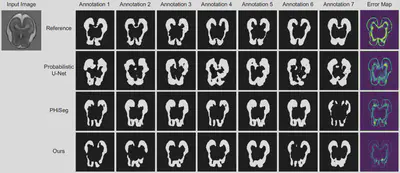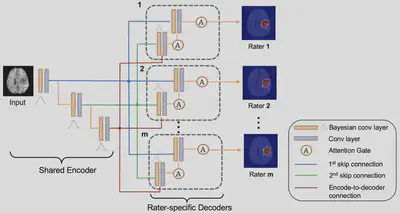In this project, we1 proposed a simple yet effective Bayesian Neural Network (BNN) framework, especifically designed for inter-rater uncertainty quantification probelm in medical imaging. We call this framework, Bayesian One-Encoder-Multiple-Decoder (BOEMD) network.

Automated medical image segmentation inherently involves a certain degree of uncerainty. One key factor contributing to this uncertainty is the ambiguity that can arise in determining the boundaries of a target region of interest, primarily due to variations in image appearance. On top of this, even among experts in the field, different opinions can emerge regarding the precise definition of specific anatomical structures. Such modeling of segmentation uncertainty, known as inter-rater uncertainty is explored and analyzed in this project.

BOEMD has three main features:
- One-Encoder-Multiple-Decoder: the only one encoder is designed to learn the shared knowledge from segmentation while the multiple decoders that are aligned with each rater (if the rater ids are known, the encoder tends to learn the specific features from each rater; otherwise, the rater ids are unknown, each decoder learns the shared knowledge as the encoder does.)
- Rater-specific Attention: each attention unit is associated with one decoder, to further enhance the ability of decoder capturing the specific knowledge from segmentation map.
- Bayesian Modelling: usually medical imaging dataset is quite small compared to other existing vision dataset, which results in the neural network over-fitting. Adopting Bayesian Modelling in our framework helps the neural network learn the dataset distribution from a high level. Doing this also reduces over-fitting.
We also introduced a rater-aligned liver tumor dataset in this work to further demonstrate the intention of our design.
Qingqiao Hu and Hao Wang made equal contribution to this project. ↩︎